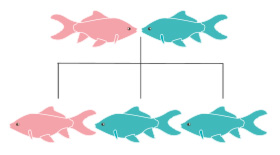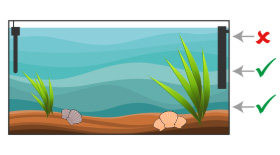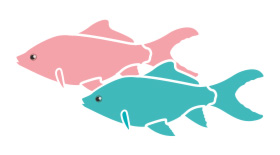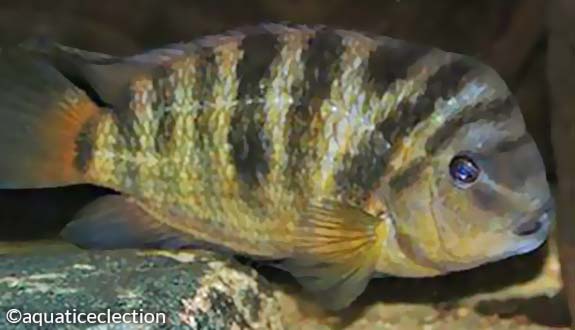

Alternative species (click on the thumbnail to see the card)
Names
Scientific name
Amatitlania siquia
Common name
Convict cichlid
Honduran Red Point Cichlid
Origin

Origin: America Central (Costa Rica, Nicaragua, Honduras)
Biotope: American
Dimorphism

Males are larger and their fins are tapered. They also have a slight nuchal bump.
Group

Cichlidae
Volume

150 L / 33 imp gal / 40 US gal
Parameters

T°: 23 to 28°C or 73 to 82°F
pH: 7 to 8
Hardness: 9 to 20°dGH
Difficulty

Easy
Size

7 to 10 cm (2.8 to 4")
Longevity

10 years
Living zone

Middle and depth
Individuals

2 (couple)
Food
How to feed the Convict cichlid?
Food
How to feed the Convict cichlid?
Very easy to feed, the only point of vigilance is to vary the menus to avoid deficiencies (alternate meat and vegetable foods in the form of fresh, frozen or dry food).
Behavior
What kind of behavior does the Convict cichlid have?
Behavior
What kind of behavior does the Convict cichlid have?
Quite quiet, this fish is nonetheless territorial (incidentally, it rarely leaves its territory). Thus, it does not appreciate the fish with too territorial temperament with which it will not share its zone of life. In the same way, its congeners can be the object of its aggressiveness. However, note that compared to many cichlids, its aggression is moderate (except during the breeding season when it defends its offspring with passion).
It lives mostly near the bottom of the aquarium.
Cohabitation
Who can live with the Convict cichlid?
Cohabitation
Who can live with the Convict cichlid?
Cohabitation with non-territorial species is generally quite good. For the territorial species, it is especially the volume and the surface on the ground which will determine the good agreement of the species: if each one finds its place and is satisfied with its territory, the things will be well. Do not hesitate to offer a lot of space for your fish for this type of configuration. In addition, it will be useful during the breeding season when the avocado cichlid becomes very territorial: the other fish will have room to move away from the fiercely defended territory.
Attention to the association with other Amatilanias because there are risks of hybridization between these species.
Breeding
How to breed the Convict cichlid?
Breeding
How to breed the Convict cichlid?
Breeding of this species is very easy! No particular protocol needs to be followed: breeding is spontaneous if your fish are in good health.
The laying is deposited in a cavity, on a flat stone, where the couple can also dig a hole under a rock (beware of the risk of landslide, see "Its aquarium"). The brood has between 100 and 150 eggs that will incubate about 48 to 72 hours (depending on temperature). The couple takes care of their little ones: the female ventilates and watches the eggs. The male goes to defend fiercely the place of laying and can be very combative during this period. Without predators, the fry survival rate is pretty good.
Fry food: finely chopped strawberries, artemia nauplies...
Its aquarium
Which aquarium for the Convict cichlid?
Its aquarium
Which aquarium for the Convict cichlid?
In their natural environment, these are fish that live in a rather congested setting, and always under cover. The water is fast and well oxygenated.
In aquariums, propose a mainly rocky decoration. The arrangement of the stones must form caves and hiding places for these cichlids. Ideally, a layout imitating a cave would be perfect! Pay attention to the stability of your decoration to avoid the risks of landslide with these big diggers (install your rocks BEFORE putting the sand, and stick the elements between them if necessary). Fill in with some big roots. Finally, when you compose the rocky environment of your aquarium, think to constitute territories, distinct and satisfactory for all the species which you plan to make coexist: you will limit the risks of disputes for the best place. To separate the territories, use the roots, plants or any other element visually separating the different areas of life.
To reproduce its natural habitat, the presence of many plants is essential. The best is either to ballast the plants that you’ll install in the ground, or to fix them to the decor. The Anubias will be useful. In all cases, choose very robust plants (Vallisneria, Cryptocoryne ...)! Floating plants are also welcome. The soil will be composed of sand (or any other non-cutting soil) and some pebbles.
Like many American cichlids, Amatitlanias are not very sensitive to the parameters of their water. Most driving water will be sufficient for good maintenance in captivity. Make sure that the water is well oxygenated with a sufficiently powerful filtration.
Good To know
Find all additional information!
Good To know
Find all additional information!
This species has been described only relatively recently (2007).
Scientists discovered for the first time in 2019 signs of attachment within a couple of Amatitlanias: "Such emotional attachment to the partner is one of the first criteria defining romantic love, which is generally considered our species. Yet this study, published in Proceedings of the Royal Society B: Biological Sciences 20190760, suggests that romantic love may be a feeling found in other species as well. It also seems that they are making efforts within the couple to adapt to each other, changing their initial behavior to adapt to their partner!
Easy to maintain, this species can be offered to novice aquarists.
Yours photos!

By Encyclo-Caro

By Encyclo-Caro

By Encyclo-Caro
Comments
Sort by:
Please login to post comments


